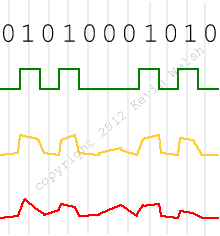There's no such thing as digital?

Yep.
Most people think of their CD Player, reel to reel, turntable or network player / music server as the "source." They put music in there, and it comes out their speakers. Most people do not consider that the power coming into these devices is the source of the source.
It turns out that just like analog gear, digital gear shines (or doesn't) based on the quality and attributes of the power supply unit (PSU) that feeds it. I should know, I have a parts graveyard filled with power supplies and prototypes from all over the world,
On the surface, Zeros are Zeros and Ones are Ones. But at the electronic level, these digits don't exist. They are represented by electrical pulses that last for a very short duration. These pulses are not discrete (digital), they are actually analog! At any point in time they can have (within a range, of course) any value. In essence, these digits are an abstraction layer built atop analog electrical flow. They are derived by measuring the properties of the system in a specific place, at a specific time.
[The intended audience for this article is not engineers. It's regular people, and those who may not have thought this hard about digital. But mostly, it's for people who say "Zeros are Zeros and Ones are Ones." They aren't]
The picture above shows a simplified view of digital information. The vertical lines depict the point in time that the processor reads (well, is supposed to read) the data point, and the number shows the “digitized value.”
The green line shows an idealized analog waveform — a perfect digital square wave. No power supply and processing system can achieve this level of perfection. The yellow line demonstrates a small degree of rise-time and fall-time for the signals, as well as non-perfect voltages. These imperfections are due to the ripple effect (AC current leaking through the PSU), EMI/RFI contamination, noise, timing uncertainties and so on. The red line shows an even worse picture of analog waveforms which, in the most extreme cases, result in an incorrect reading of the actual data.
Keep in mind that it is not just the data signal which depends on the PSU. The clocks themselves do, too. And so do the comparators that take the measurements.
When you consider that the "zero value of ground" also depends on the noise (or hopefully lack of) coming from the supply, and that a signal is typically measured in comparison to ground, you start to see two things:
- Poorly engineered PSUs lead to poorly executed digital sources.
- Zeros and Ones are an illusion.
So the next time someone tries to tell you that all digital is the same, or that a signal taken off a PC motherboard is audiophile grade, or that switching power supplies sound as good as linear… take an extra second to think about it.
Then, do what we do, and let your ears decide.